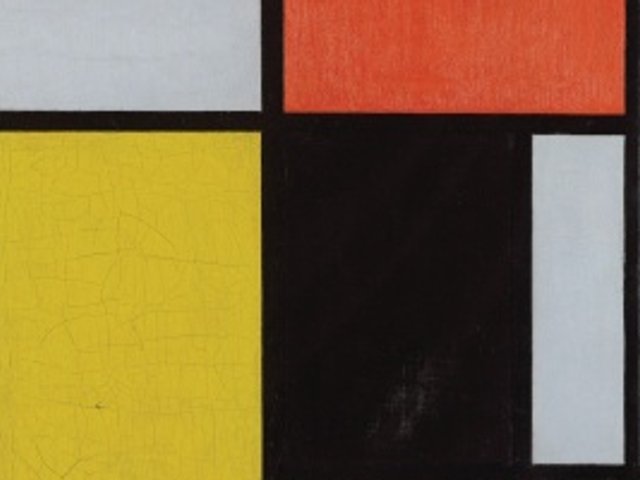Every painting by Piet Mondrian (1872-1944) in the Gemeentemuseum’s collection has been scrutinised by conservators as part of the Dutch institution’s major Mondrian Restoration Project. The public is sure to reap the benefits of this initiative when the museum’s landmark exhibition on Mondrian opens on 3 June.
The show features 301 paintings, drawings and sketches—every work by Mondrian in the museum’s collection, from the very first piece he exhibited (Basket with Hare (1891)) to his final composition (Victory Boogie Woogie (1942-44))—including pieces coming out of storage for the first time in decades and those that have been on loan to other institutions. It is an exhibition that only the Gemeentemuseum—the world’s largest repository of works by Mondrian—could stage and, importantly, one that “is only possible because all of the works have been treated,” says the paintings conservator Ruth Hoppe.
She knew that the project, which launched officially in 2009 and was sponsored by the BankGiro Loterij, required a systematic approach because it involved a large group of paintings—159 in total—by such an important artist in the collection. “We can’t just treat one [painting] and then treat another in ten years,” she says. “As individual paintings, they need to look uniform within the context of this collection.” (The treatment of Mondrian’s drawings has been ongoing for the past ten to 20 years.) The project’s success has led the museum to consider applying this across-the-board approach to other areas of the collection, where specific groups or “clusters” can be identified.
The project relied on visual observations as opposed to technical research or analysis, and began with a three-month collection survey to assess the paintings’ condition and prioritise the ones that needed urgent attention. This led to 120 pictures receiving some form of treatment ranging from dusting and reframing to structural interventions such as the consolidation of paint, replacing stretchers, strip lining and complicated cleaning treatments (surface dirt and/or varnish removal). But Hoppe says that most paintings were in good condition.
Intense study of such a large corpus of works by a single artist, carefully documenting details such as weave type and count, type of support and colour of the ground layers, enabled conservators to recognise patterns and guess the type of ailments that works might be suffering from. Flaking paint, for example, was found on several works on a canvas with a special basket-weave pattern, so when they came across paintings on these types of canvas they knew that they needed to be put under the microscope for closer inspection. “Nine out of ten times we were right,” she says.
For the Mondrian expert and curator of the exhibition Hans Janssens, the project reaffirmed the painterliness of Mondrian. He also says that cleaning the works has laid bare details handed down by art historians from generation to generation. He singles out one early work, Farm with Trees (1906), as acquiring a new significance thanks to the efforts of the conservation team. “It had played a minor role in our collection because it was very dark,” he says. But the removal of old, dirty varnishes revealed previously obscured barns, fields and hedges. “It’s almost as if we were given a new picture as a gift,” he says, adding that it also shows that Mondrian was already working along the same compositional principles that would govern his whole life. He didn’t follow the rules of traditional perspective; instead “he worked in the Dutch manner of building up the surface of the picture plane to suggest depth”.
As well as some spectacular varnish and surface dirt removals that allowed colours to pop and paint surfaces to come alive, the treatments set about righting some wrongs. For example, conservators found that one painting had been reframed the wrong way around. Mondrian often continued to work on his compositions in their frames and so paint from the canvas could end up on the frame (or vice versa if he painted the frame). Conservators noticed that the position of the paint traces on the frame did not correspond with the canvas. Hoppe thinks the picture was probably removed from its frame to be photographed. “The frame was put back on upside down so we turned it back to the correct position,” she says.
Some pieces required more complex interventions. One conservator spent three of the six months that Red Tree (1908-10) was in the conservation studio under the microscope, consolidating paint. Two specialists were tasked with treating a large-scale work from Mondrian’s Dune series, made during summers spent on the North Sea coast of Zeeland, the Netherlands. The painting was almost falling off its stretcher because the canvas around the corroded metal tacks had been eaten away. “We had to remove it from the stretcher, make a strip lining, put it back on the stretcher and do a lot of consolidation,” Hoppe says.

For Hoppe, the team aspect was one of the most rewarding aspects of the project and essential to finishing the project on a very tight deadline. “Sometimes we had ten Mondrians in the studio at once, which was a fantastic sight,” she says.
Did you know?

• Many of Mondrian’s early works were painted on cardboard
• He invented the thin (often white) wood-slat frames around his abstract works
• Mondrian often continued to work on paintings after they were framed
• He experimented with different colour ground layers, including orange and blue
• An abundance of flies was found on several works, including The Red Mill (1911)
• The Discovery of Mondrian, Gemeentemuseum, The Hague, 3 June-24 September



